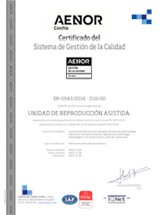The center, which collaborates with the Reproduction Unit Vistahermosa, presented this study at the I Interdisciplinary Congress of Human Genetics held in Madrid
 Ectrodactyly or split-split hand syndrome (SHFM) is a heterogeneous congenital disorder, characterized by the absence of the central rays of the hands and feet, which randomly affects one to four limbs. The most common features are sindactylide with oligodactyly, the medial clefts of the hands and feet and the opposing fingers, which gives rise to the appearance known as “lobster claw.”
Ectrodactyly or split-split hand syndrome (SHFM) is a heterogeneous congenital disorder, characterized by the absence of the central rays of the hands and feet, which randomly affects one to four limbs. The most common features are sindactylide with oligodactyly, the medial clefts of the hands and feet and the opposing fingers, which gives rise to the appearance known as “lobster claw.”
It is a syndrome with an autosomal dominant mode of inheritance, incomplete penetrance (less than 50%) and variable expressiveness, which may affect one or more extremities. Long-bone deficiency SHFM syndrome (SHFLD3, MIM # 612576) associated with duplications of the 17p13.3 cytobanda is described in OMIM. In this region is the candidate gene responsible for the syndrome, called BHLHA9, which codes for a transcription factor related to the development of the extremities.
Dr. Isabel Ochando, head of the Cytogenetic Area and the Quality Program of the Vistahermosa Genetics Unit, recently presented a clinical case related to the disease at the First Interdisciplinary Congress on Human Genetics held in Madrid from 25 to 28 April . It is a 6-month-old boy with ectrodactyly in both hands, two fingers in the left hand and three fingers in the right hand.
The Genetics Unit team conducted a CGH array study on the patient that allowed the identification of a duplication of the 17p13.3 cytobanda, which includes the BHLHA9, TUSC5 and YWHAE genes. Therefore, the results of this study allow us to conclude that in cases of long bone aplasia or ectrodactyly not including all four limbs, the study of duplications in the BHLHA9 gene should be considered.
which includes the BHLHA9, TUSC5 and YWHAE genes. Therefore, the results of this study allow us to conclude that in cases of long bone aplasia or ectrodactyly not including all four limbs, the study of duplications in the BHLHA9 gene should be considered.










